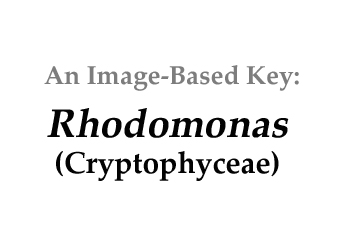|
|
||||
|
Click on images for larger format |
||||
Name derivation: |
||||
|
“Red
monad” Although
still recognized by some phycologists/protistologists, others including
Santore (1984) based on ultrastructural similarity to Cryptomonas and the apparent ability to undergo chromatic
adaptation by changing the relative abundance of the phycobilins, one might
consider Rhodomonas to be a synonym
of Cryptomonas. |
||||
Classification: |
||||
|
Rhodomonas Karsten 1898; 14 of 27 species descriptions are currently accepted taxonomically (Guiry and Guiry 2013). Class Cryptophyceae; Order Pyrenomonadales |
||||
Morphology: |
||||
|
Biflagellate unicells with a short furrow that transforms posteriorly into a tubular gullet lined with two to four (or more) rows of ejectisomes. One chloroplast and pyrenoid. Color is determined by the concentration of phycoerithrin (red phycobolin) and varies from red-brown to yellow and even green in older cells (Guiry and Guiry 2013). Excellent description of the morphology of photosynthetic cryptomonads can be found in Santore (1984).
|
||||
Similar genera: |
||||
|
|
||||
Habitat: |
||||
|
Marine plankton with reports from freshwater plankton that are unconfirmed because of dubious similarity to marine species. Distributed widely in oceans, the first disdovery was in the Baltic Sea (Karsten 1898).
|
||||
References: |
||||
|
Karsten, G. (1898). Rhodomonas baltica, n.g. et sp.Wiss. Meeresunters. N.F. Abt. Kiel 3: 15-16. Santore, U.J. 1984. Some aspects of taxonomy in the Cryptophyceae. New Phytol. 98:627–646. |
||||


